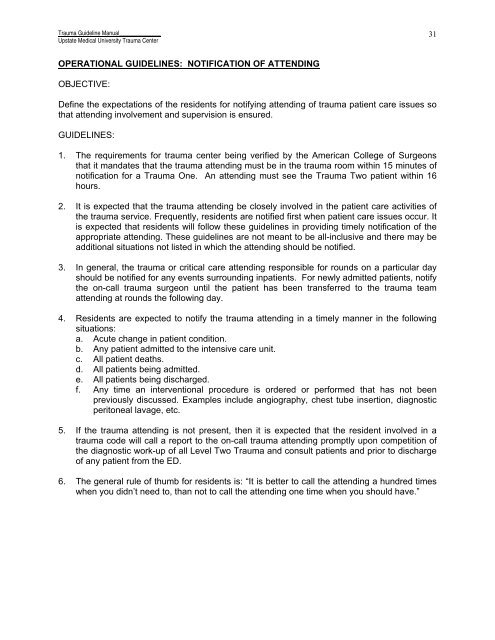Trauma Guideline Manual - SUNY Upstate Medical University
Trauma Guideline Manual - SUNY Upstate Medical University
Trauma Guideline Manual - SUNY Upstate Medical University
Create successful ePaper yourself
Turn your PDF publications into a flip-book with our unique Google optimized e-Paper software.
<strong>Trauma</strong> <strong>Guideline</strong> <strong>Manual</strong>______________<strong>Upstate</strong> <strong>Medical</strong> <strong>University</strong> <strong>Trauma</strong> Center31OPERATIONAL GUIDELINES: NOTIFICATION OF ATTENDINGOBJECTIVE:Define the expectations of the residents for notifying attending of trauma patient care issues sothat attending involvement and supervision is ensured.GUIDELINES:1. The requirements for trauma center being verified by the American College of Surgeonsthat it mandates that the trauma attending must be in the trauma room within 15 minutes ofnotification for a <strong>Trauma</strong> One. An attending must see the <strong>Trauma</strong> Two patient within 16hours.2. It is expected that the trauma attending be closely involved in the patient care activities ofthe trauma service. Frequently, residents are notified first when patient care issues occur. Itis expected that residents will follow these guidelines in providing timely notification of theappropriate attending. These guidelines are not meant to be all-inclusive and there may beadditional situations not listed in which the attending should be notified.3. In general, the trauma or critical care attending responsible for rounds on a particular dayshould be notified for any events surrounding inpatients. For newly admitted patients, notifythe on-call trauma surgeon until the patient has been transferred to the trauma teamattending at rounds the following day.4. Residents are expected to notify the trauma attending in a timely manner in the followingsituations:a. Acute change in patient condition.b. Any patient admitted to the intensive care unit.c. All patient deaths.d. All patients being admitted.e. All patients being discharged.f. Any time an interventional procedure is ordered or performed that has not beenpreviously discussed. Examples include angiography, chest tube insertion, diagnosticperitoneal lavage, etc.5. If the trauma attending is not present, then it is expected that the resident involved in atrauma code will call a report to the on-call trauma attending promptly upon competition ofthe diagnostic work-up of all Level Two <strong>Trauma</strong> and consult patients and prior to dischargeof any patient from the ED.6. The general rule of thumb for residents is: “It is better to call the attending a hundred timeswhen you didn’t need to, than not to call the attending one time when you should have.”
















